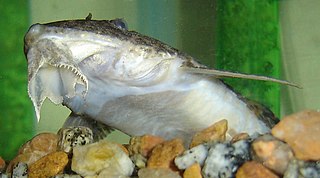
Hypostomus is a genus of catfish in the family Loricariidae. They are native to tropical and subtropical South America. H. plecostomus is the popular freshwater aquarium fish formerly known as Plecostomus plecostomus. The taxonomic structure of the Loricariidae is still being expanded by scientists. Hypostomus is a highly species-rich and widely distributed catfish genus.
Hypostomus punctatus, the suckermouthed catfish, is a tropical fish belonging to the armored suckermouth catfish family, Loricariidae. Hypostomus punctatus is a freshwater fish native to South America, in the coastal drainages of southeastern Brazil and Uruguay. It is one of a number of species commonly referred to as "plecostomus" or "common pleco" by aquarists.

Rineloricaria is a genus of freshwater tropical catfish belonging to the family Loricariidae. They are commonly called whiptail catfish because of the long filament that grows out of the tip of the caudal fin that is characteristic of the genus. With the exception of R. altipinnis from Panama, they are native to the rivers of northern and central South America. Some species are regularly seen in the aquarium trade.

Pterygoplichthys pardalis, the Amazon sailfin catfish, is a freshwater tropical fish in the armored catfish family (Loricariidae). It is one of a number of species commonly referred to as the common pleco or "leopard pleco" by aquarists.
Otocinclus flexilis, known in the aquarium trade as the peppered otocinclus, is a species of catfish in the family Loricariidae. It is native to South America, where it is known from the Lagoa Dos Patos drainage basin in Brazil. The species reaches 6.8 cm in total length.
Hisonotus brunneus is a species of catfish in the family Loricariidae. It is native to South America, where it occurs in the Jacuí River and Lagoa dos Patos drainage basins in Brazil. The species reaches 4.2 cm SL.
Hisonotus heterogaster is a species of catfish in the family Loricariidae. It is a freshwater fish native to South America, where it occurs in the Jacuí River basin and the Lagoa dos Patos system in Brazil. It reaches 4.3 cm SL.
Hisonotus vireo is a species of catfish in the family Loricariidae. It is native to South America, where it occurs in the Jacuí River basin and the Lagoa dos Patos system in Brazil. The species reaches 4 cm SL.
Aphanotorulus gomesi is a species of catfish in the family Loricariidae. It is native to South America, where it occurs in the Jaguaribe River basin. The species reaches 14.3 cm SL. It is thought to be a facultative air-breather.
Aphanotorulus unicolor is a species of catfish in the family Loricariidae. It is native to South America, where it occurs in the upper Amazon River basin. The species reaches 13.9 cm SL.
Hypostomus agna is a species of catfish in the family Loricariidae. It is native to South America, where it occurs in the Ribeira de Iguape River basin. It was formally described as a new species in 1907 by Brazilian ichthyologist Alípio de Miranda-Ribeiro, as a species of Plecostomus.
Hypostomus brevis is a species of catfish in the family Loricariidae. It is native to South America, where it is known from the Paraná River basin in Brazil. The species reaches 7.4 cm SL and is believed to be a facultative air-breather.
Hypostomus formosae is a species of catfish in the family Loricariidae. It is a freshwater species native to South America, where it occurs in the Paraguay River basin. The species reaches at least 24.9 cm SL.
Hypostomus hermanni, sometimes known as Hermann's pleco, is a species of catfish in the family Loricariidae. It is native to South America, where it occurs in the Tietê River basin, including the Piracicaba River, in Brazil. It is typically found in areas with flowing water of shallow to moderately shallow depth. The species reaches 24 cm in total length and is believed to be a facultative air-breather.

Hypostomus regani is a species of catfish in the family Loricariidae. It is native to South America, where it occurs in the basins of the Paraná River, the Paraguay River, and the Uruguay River. The species reaches 41 cm SL and is believed to be a facultative air-breather.

Hypostomus wilsoni is a species of catfish in the family Loricariidae. It is native to South America, where it occurs in the basin of the Truando River, which is part of the Atrato River drainage in Colombia. The species reaches 32.5 cm in total length and is believed to be a facultative air-breather.
Hypostomus arecuta is a species of catfish in the family Loricariidae. It is a freshwater fish native to South America, where it occurs in the Paraná River in Argentina.
Hypostomus boulengeri is a species of catfish in the family Loricariidae. It is native to South America. The species reaches 24.5 cm SL and is believed to be a facultative air-breather.
Hypostomus carinatus is a species of catfish in the family Loricariidae. It is native to South America, where it occurs in the middle Amazon River basin. The species reaches 24.8 cm SL and is believed to be a facultative air-breather.

Hypostomus commersoni is a species of catfish in the family Loricariidae. It is native to South America, where it occurs in the Paraná River drainage, including the Iguazu River, the Paraguay River, the Río de la Plata, and the Dulce River. It is typically found in rivers with muddy substrates and moderate currents. The water that H. commersoni inhabits usually has a temperature of 16.8 to 27.8 °C, a pH of 7.2 to 9.2, a turbidity of 23.7 to 442 NTU, an oxygen concentration of 6.1 to 9.1 mg/L, and a conductivity of 1.087 to 2.654 μS/cm.





